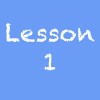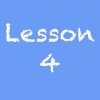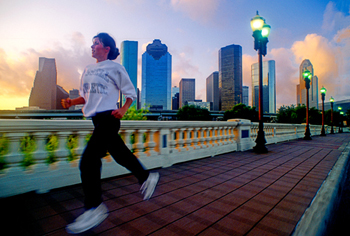Stretching Your Frame of Mind, Part II
Stretching Your Frame of Mind, Part II
02MINE18 LS1

Take Lesson
02MINE18 LS2

Take Lesson
02MINE18 LS3

Take Lesson
02MINE18 LS4

Take Lesson
 In part one, we talked about your new ‘Artist Palette’, and the ‘elements’ of design and composition that are now (hopefully) indelibly ingrained in your visual thought process.
In part one, we talked about your new ‘Artist Palette’, and the ‘elements’ of design and composition that are now (hopefully) indelibly ingrained in your visual thought process.
Negative space, Vanishing Point, Tension, Perspective, Texture, Pattern, Line, Light, and Color. These are the ‘ingredients’ that when either used by themselves, or in pairs or groups have been proven to take our imagery “up a level”.
You are the proof. It’s your new level of photographic expertise and personal desire that has prompted me to help take your photography up to even a higher level.
Part two’s journey in the four week course will begin with the ‘Artist Palette’, and a refresher week on implementing those ‘elements’ into your ‘works of art’ because if you remember, you’re artists, your medium is now a camera, and the canvas is now electronic. This will also be a good time to resurrect the “does it” list for good composition.
In the following three weeks, we’ll concentrate on LIGHT and COLOR, and how they ‘define’ these elements.
In working with COLOR, I’ll talk about ways to manipulate its value, as well as the role of the ‘quality of light’ in its ability to determine and control color saturation. We’ll work with color as a way to communicate ideas, and we’ll study through assignments, the psychological effect of certain colors, and how they can set the mood in our imagery.
LIGHT is everything, and it needs to be foremost in your mind, to be evaluated first�even before you begin to frame your visual idea on your ‘canvas’.
Part II will be a more in-depth study of how light affects all the basic ‘elements’ of design, and there will be specific assignments on using back, side, and front light. We’ll also be spending time on how these different approaches to lighting changes the effect and mood of the ‘environmental portrait’.
Also, we’ll be talking about the difference between ‘incident and reflected light’, and why knowing that difference is so important in getting the various exposures in your composition where they need to be.
Extra time will be donated to my favorite way to light a subject�by putting it into the Angle of Incidence. If you remember, the ‘angle of incidence = the angle of reflection’.

In part II we’ll discuss how important ‘shadows’ are, and through exercises you’ll discover how shadows create moods, draws attention to specific areas, and alters shapes.
Finally, we’ll work on shooting in Golden Light, since it’s the best way to make everything in this entire lesson look better. Since people work, weekend will provide you with that time. Hopefully the class will take advantage of shooting at dawn to sunrise and sunset to dusk, since it’s the best way I know of to come home with a big smile on your face, and proud of what you’re downloading onto your computer.
Knowing what and where you’re going to shoot ahead of time is the only way to know for sure if you’re at the right place at the right time during ‘golden light’. This takes scouting, and sometimes pre-production.
I’m all for being lucky enough to wind up at a location at the right time and getting a “keeper”; it’s certainly happened to me in the past forty years. However, going to a location ahead of time with a notebook and pen, and writing down compositional ideas, and determining where the sun and shadows will be is a much better way to begin your hunt for that illusive and somewhat ‘esoteric’ “OMG” shot.
Isn’t that what’s it’s all about?
Oh, and don’t forget to bring your new “fifteen point inspection plan”!!!!!!

Course Requirement:
In order to take this class, you have to take “Stretch Your Frame of Mind, Part I” first.
Instructor: Joe Baraban
 After receiving his BA in Journalism, Joe ventured out into the freelance world and never looked back. For the past forty years, Joe has shot professionally for clients from Coca Cola to Hennessy, Cessna to United Air Lines and Boeing, and from Microsoft to IBM and HP. He has shot the full line car brochures for Acura, Saturn, and Range Rover, not to mention campaigns for Acura, Jaguar, Mazda and Ford. The tourism departments for Alberta, Canada, Pennsylvania, Alabama, and Texas have contracted Joe to shoot images for their state campaigns. Just to name a few.Joe spent his early years shooting for AP, UPI, and was a Black Star photographer. Over the years, National Geographic, Life, Texas Monthly, Time, Geo, Newsweek, and the New York Times Magazine have used Joe for several of their editorial assignments.Teaching people how to use their eye has always been one of Joe’s passions, and he’s conducted his personal workshops around the world and also with organizations including: The Maine Media Workshop (twenty-seven years), The Santa Fe Workshop, The Julia Dean Workshop in Hollywood, The South Florida Workshop, The Pacific Northwest School of Art on Whidbey Island, The Texas Photographic Workshop, Objectif’s, a photographic organization in Singapore, and The Houston Center for Photography. Joe has also conducted continuing education classes at Rice University.Joe in conjunction with the Santa Fe Workshops and Epic Photo Tours, is now leading workshops to Cuba, Myanmar, and Viet Nam.He has been sought out as a guest speaker for various ASMP chapters (American Society of Media Photographers), advertising and art director’s clubs across the country, The Art Center in Pasadena, California, and Brooks Institute. He has given seminars at Photo East in New York, Photo West in San Francisco, and Viacom (the national photographic convention in Canada).
After receiving his BA in Journalism, Joe ventured out into the freelance world and never looked back. For the past forty years, Joe has shot professionally for clients from Coca Cola to Hennessy, Cessna to United Air Lines and Boeing, and from Microsoft to IBM and HP. He has shot the full line car brochures for Acura, Saturn, and Range Rover, not to mention campaigns for Acura, Jaguar, Mazda and Ford. The tourism departments for Alberta, Canada, Pennsylvania, Alabama, and Texas have contracted Joe to shoot images for their state campaigns. Just to name a few.Joe spent his early years shooting for AP, UPI, and was a Black Star photographer. Over the years, National Geographic, Life, Texas Monthly, Time, Geo, Newsweek, and the New York Times Magazine have used Joe for several of their editorial assignments.Teaching people how to use their eye has always been one of Joe’s passions, and he’s conducted his personal workshops around the world and also with organizations including: The Maine Media Workshop (twenty-seven years), The Santa Fe Workshop, The Julia Dean Workshop in Hollywood, The South Florida Workshop, The Pacific Northwest School of Art on Whidbey Island, The Texas Photographic Workshop, Objectif’s, a photographic organization in Singapore, and The Houston Center for Photography. Joe has also conducted continuing education classes at Rice University.Joe in conjunction with the Santa Fe Workshops and Epic Photo Tours, is now leading workshops to Cuba, Myanmar, and Viet Nam.He has been sought out as a guest speaker for various ASMP chapters (American Society of Media Photographers), advertising and art director’s clubs across the country, The Art Center in Pasadena, California, and Brooks Institute. He has given seminars at Photo East in New York, Photo West in San Francisco, and Viacom (the national photographic convention in Canada).
Joe has had feature articles written about his work in Communication Arts Magazine, Photo District News, Japan’s Portfolio Magazine, and Studio Magazine. His work has appeared in CA, Photo Graphis, and The Mead Annual Report Show. His expertise had also spurred an invitation to judge the prestigious Communication Arts Photography Annual.
He currently has four of his Fine Art photographs in the permanent photography collection at the Museum of Fine Arts in Houston, headed by world acclaimed photography curator Ann Tucker.

